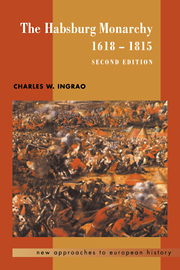Book contents
- Frontmatter
- Contents
- List of maps
- Genealogical tables
- Preface
- 1 The distinctiveness of Austrian history
- 2 The Thirty Years' War (1618–1648)
- 3 Facing east: Hungary and the Turks (1648–1699)
- 4 Facing west: the second Habsburg empire (1700–1740)
- 5 The Prussian challenge: war and government reform (1740–1763)
- 6 Discovering the people: the triumph of cameralism and enlightened absolutism (1765–1792)
- 7 The age of revolution (1789–1815)
- 8 Decline or disaggregation?
- Bibliography
- Index
- More titles in the NEW APPROACHES TO EUROPEAN HISTORY series
2 - The Thirty Years' War (1618–1648)
- Frontmatter
- Contents
- List of maps
- Genealogical tables
- Preface
- 1 The distinctiveness of Austrian history
- 2 The Thirty Years' War (1618–1648)
- 3 Facing east: Hungary and the Turks (1648–1699)
- 4 Facing west: the second Habsburg empire (1700–1740)
- 5 The Prussian challenge: war and government reform (1740–1763)
- 6 Discovering the people: the triumph of cameralism and enlightened absolutism (1765–1792)
- 7 The age of revolution (1789–1815)
- 8 Decline or disaggregation?
- Bibliography
- Index
- More titles in the NEW APPROACHES TO EUROPEAN HISTORY series
Summary
The monarchy and the “general crisis”
The difficulties posed by the monarchy's diversity and exposed central European position preoccupied its rulers throughout its history. These problems were, however, compounded by other challenges that confronted it and much of the rest of European society at the beginning of the seventeenth century. Over the past generation most historians have accepted the notion that Europe was then in the throes of a “General Crisis” as it tried to adjust to the dramatic developments that had taken place over the previous century. The economy was changed forever by the dramatic expansion in trade and by the inflation, or “price revolution,” caused by the influx of silver from the New World. Europe had heretofore had a predominantly barter- and subsistence-oriented agrarian economy controlled by landowning nobles, but worked by their peasant labor force. It now began slowly converting to a money- and market-oriented economy controlled by the bourgeoisie and other capitalist elements seeking higher profits from trade and industry, as well as from agriculture. International relations were revolutionized by the sudden emergence of the new Habsburg world empire and the almost perpetual wars between it and its two natural enemies, France and the Ottoman empire. The need to feed the resulting arms race transformed domestic politics into a struggle between rulers and their people over the power to tax. Finally, the monarchs' concern for the security of their realms extended to their growing insistence on religious uniformity among their subjects, lest the growth of heresy inspire rebellion or civil war.
- Type
- Chapter
- Information
- The Habsburg Monarchy, 1618–1815 , pp. 23 - 52Publisher: Cambridge University PressPrint publication year: 2000



